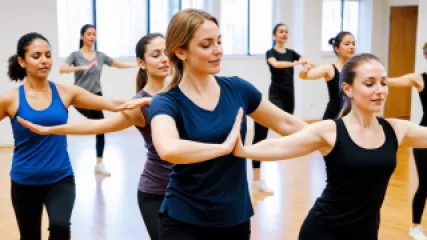Exploring the Power of Dance Movement Therapy in Mental Health
Exploring the Power of Dance Movement Therapy in Mental Health
In a world that often prioritizes the rational and the logical, the transformative power of dance movement therapy (DMT) stands as a powerful reminder that our physical bodies and emotional experiences are inextricably linked. As an Eva Young, I have witnessed firsthand the profound impact that this holistic approach can have on individuals struggling with a range of mental health challenges.
At its core, DMT recognizes that the mind and body are not separate entities, but rather interconnected systems that shape and inform one another. By tapping into the inherent rhythms and movements of the human body, DMT practitioners guide clients on a journey of self-discovery, empowerment, and healing. Through the integration of dance, music, and guided embodied exploration, individuals are invited to access and express emotions, process trauma, and cultivate greater self-awareness and resilience.
The Neurological Benefits of Dance Movement Therapy
Numerous studies have demonstrated the profound neurological benefits of DMT, showcasing its ability to positively impact brain function and overall well-being. When we engage in dance and movement, the brain releases a host of feel-good neurotransmitters, such as dopamine, serotonin, and endorphins, which can help alleviate symptoms of depression, anxiety, and stress.
Moreover, the rhythmic and improvisational nature of DMT has been shown to stimulate the prefrontal cortex, the region of the brain responsible for decision-making, problem-solving, and emotional regulation. By activating this crucial area, DMT can enhance cognitive function, improve impulse control, and foster a greater sense of emotional stability.
Interestingly, research has also indicated that DMT can have a particularly profound impact on individuals struggling with trauma-related disorders. The physical movements and embodied experiences inherent in DMT can help individuals process and integrate traumatic memories, leading to a greater sense of bodily autonomy and emotional regulation.
"Dance movement therapy allows individuals to access and express emotions that may be difficult to articulate through words alone. By engaging the body, clients can tap into the inherent wisdom and resilience of the physical form, unlocking new pathways for healing and personal growth." - Raymond Harrison, Registered Dance Movement Therapist
The Holistic Approach of Dance Movement Therapy
Unlike traditional talk therapy, which primarily focuses on the cognitive and verbal aspects of the human experience, DMT takes a more holistic approach, recognizing the profound interconnectedness of the mind, body, and spirit. By incorporating the physical, emotional, and creative dimensions of the individual, DMT practitioners are able to address a wide range of mental health concerns, from depression and anxiety to trauma and addiction.
One of the key benefits of this holistic approach is its ability to foster self-expression and emotional processing in a safe and supportive environment. Through the use of improvised movement, clients are encouraged to tap into their inner worlds, expressing feelings and experiences that may be difficult to articulate through words alone. This embodied exploration can lead to a deeper understanding of one's own emotional landscape, as well as a greater sense of self-acceptance and empowerment.
Moreover, the collaborative and interactive nature of DMT sessions can help to build meaningful connections between clients and their therapists, as well as among members of a group. This sense of community and shared experience can be especially valuable for individuals who may be feeling isolated or disconnected from their support systems.
The Accessibility of Online Dance Movement Therapy
In recent years, the COVID-19 pandemic has accelerated the adoption of virtual healthcare services, including the provision of dance therapy benefits through online dance therapy programs. While the physical nature of DMT may initially seem at odds with a virtual setting, practitioners have risen to the challenge, developing innovative ways to facilitate dance movement therapy online sessions and online dance therapy workshops that maintain the core principles and benefits of this powerful modality.
One of the key advantages of virtual dance therapy programs is their increased accessibility. Individuals who may have faced barriers to in-person therapy, such as geographic location, physical mobility limitations, or social anxiety, can now access the transformative power of DMT from the comfort of their own homes. This expanded reach has the potential to make DMT more inclusive and equitable, ensuring that those who need it most can benefit from its emotional healing through movement.
Moreover, the virtual setting can also enhance the sense of safety and privacy for some clients, allowing them to explore their emotions and physical experiences without the perceived pressure of an in-person setting. This can be particularly beneficial for individuals who have experienced trauma or who are hesitant to engage in more traditional therapeutic modalities.
The Transformative Potential of Dance Movement Therapy
As an Eva Young, I have witnessed the profound transformations that can occur through the practice of dance movement therapy. Whether it's a client who finds the courage to express long-buried grief through a series of fluid movements, or a group of individuals who discover a newfound sense of connection and community through shared dance, the power of DMT to facilitate emotional healing through movement is truly remarkable.
At its core, DMT is a testament to the inherent wisdom and resilience of the human body. By embracing the innate rhythms and expressions of our physical forms, we can unlock pathways to self-discovery, emotional processing, and personal growth that may have been previously inaccessible. In a world that often emphasizes the primacy of the mind, DMT reminds us that our bodies are not mere vessels, but rather essential components of our overall well-being and our ability to navigate the complexities of the human experience.
As the field of mental health continues to evolve, I believe that the transformative power of dance movement therapy will only continue to gain recognition and momentum. Whether accessed through in-person sessions or virtual dance therapy programs, DMT offers a unique and holistic approach to personal healing and transformation, one that has the potential to profoundly impact the lives of countless individuals.
In conclusion, the exploration of dance movement therapy in the realm of mental health is a journey of profound self-discovery and emotional healing. By embracing the interconnectedness of the mind, body, and spirit, DMT practitioners are able to guide clients towards a greater sense of self-awareness, resilience, and overall well-being. From the neurological benefits of dance and movement to the holistic and accessible nature of this modality, the transformative potential of DMT is truly remarkable.
As an Eva Young, I am deeply passionate about the power of DMT to facilitate emotional healing through movement and to provide individuals with the tools and support they need to navigate the complexities of the human experience. Whether through dance therapy benefits experienced in online dance therapy programs or the profound connections forged in dance movement therapy online sessions, I believe that this approach has the potential to revolutionize the way we approach mental health and personal growth.
So, I invite you to explore the world of dance movement therapy, to open your mind and your body to the possibilities of emotional healing through movement. Let the rhythms and expressions of your physical form guide you on a journey of self-discovery, empowerment, and transformation. Who knows what wonders may unfold when we embrace the inherent wisdom of the human body and the power of dance to heal, inspire, and uplift.






